
About UsThe Numismatic Bibliomania Society is a non-profit organization promoting numismatic literature. For more information please see our web site at coinbooks.org SubscriptionsThose wishing to become new E-Sylum subscribers (or wishing to Unsubscribe) can go to the following web page link MembershipThere is a membership application available on the web site Membership Application To join, print the application and return it with your check to the address printed on the application. Membership is only $15 to addresses in the U.S., $20 for First Class mail, and $25 elsewhere. For those without web access, write to: David M. Sundman, Secretary/TreasurerNumismatic Bibliomania
Society AsylumFor Asylum mailing address changes and other membership questions, contact David at this email address: dsundman@LittletonCoin.com SubmissionsTo submit items for publication in The E-Sylum, just Reply to this message, or write to the Editor at this address: whomren@coinlibrary.com
BUY THE BOOK BEFORE THE COINYou won't regret it! |
- WAYNE'S WORDS: THE E-SYLUM DECEMBER 12, 2010
- NEW EDITION: THE COIN COLLECTOR'S SURVIVAL MANUAL, 7TH EDITION
- CORRECTION: ANNUAL ASSAY COMMISSION – UNITED STATES MINT 1800-1943
- CONTENTS: THE SECRET HISTORY OF THE FIRST U.S. MINT
- SPECIAL OFFER ON ADAMS BOOKS ON AMERICAN MEDALS
- LAST CHANCE TO GET YOUR GETZ
- MORE ON NUMISMATIC PUBLISHER AL HOCH AND THE COLONIAL NEWSLETTER
- SCOTT'S COIN COLLECTOR'S JOURNAL – A SURVEY
- TWENTY QUESTIONS INSPIRED BY MICHAEL POWILLS CORRESPONDENCE
- THE PHILADELPHIA MINT EXHIBIT OF THE LOUIS ELIASBERG COIN COLLECTION
- FRED LAKE ON HARRY X BOOSEL
- QUIZ ANSWER: JENNY LIND, THE SWEDISH NIGHTINGALE
- FOLLOW-UP: SABINE PASS MEDAL COPIES
- MORE ON THE TRUMAN LIBRARY COIN COLLECTION
- MORE ON COUNTERFEITED 1910 20-MARK REICHSBANKOTES
- GREEN [SPACE] DUCK WAS ORIGINALLY GREENDUCK CORPORATION
- NOTES FROM E-SYLUM SUBSCRIBERS: DECEMBER 12, 2010
- WAYNE'S NUMISMATIC DIARY: DECEMBER 12, 2010
- MORE ON THE 1962 SEATTLE WORLD'S FAIR MILLION SILVER DOLLAR EXHIBIT
- CONTINUED PROBLEMS WITH THE NEW $100 BILL
- YAP: THE ISLAND OF STONE MONEY
- CANADIAN SCIENTISTS USING ANCIENT COINS TO MAP TRADING ROUTES
- ARCHEOLOGISTS PONDER REASONS FOR FROME HOARD OF ROMAN COINS
- HOW PERU BECAME THE COUNTERFEIT-CASH CAPITAL OF THE WORLD
- MORE ON THE RECOVERY OF JULIAN LEIDMAN'S STOLEN INVENTORY
- NEW COIN: AUSTRIAN PUMMERIN BELL FIVE EUROS
- MEDAL BACK IN MALTESE HANDS AFTER AUCTION
- FEATURED WEB SITE: U.S LARGE CENTS OF THE YEAR 1794
WAYNE'S WORDS: THE E-SYLUM DECEMBER 12, 2010

Among our new subscribers this week are Dean Tatulinski, courtesy of John Burns, Leslie Citrome, and Joe Paonessa. Welcome aboard! We now have 1,387 email subscribers, plus 103 followers on Facebook, including Eko Santozo, Jeanne D. Arc and Evgeni Paunov.
This week we open with information on a new edition of Scott Travers' Coin Collector's Survival Manual, more information on the recent Assay Commission and Philadelphia Mint books, and special offers and reminders from literature dealers Kolbe & Fanning.
Other topics this week include The Colonial Newsletter, Green Duck Corporation, Yap stone money, Peruvian counterfeiters, and King Farouk's collection of erotica.
To learn more about Jenny Lind, the Eliasberg collection exhibit at the U.S. Mint, Jenny Lind, and the 1962 Seattle silver dollar exhibit, read on. Have a great week, everyone!
Wayne Homren
Numismatic Bibliomania Society
NEW EDITION: THE COIN COLLECTOR'S SURVIVAL MANUAL, 7TH EDITION
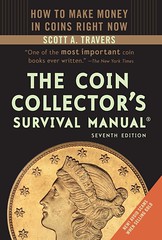 Gold and grading share the spotlight in The Coin Collector's Survival Manual, Seventh Edition, the just-released latest edition of the perennial hobby bestseller by award-winning author Scott A. Travers. Published by Random House, this thoroughly updated 400-page book also contains two new and timely fact-filled chapters; one on buying and selling gold coins and other precious metal items, the other on recent innovations in coin grading.
Gold and grading share the spotlight in The Coin Collector's Survival Manual, Seventh Edition, the just-released latest edition of the perennial hobby bestseller by award-winning author Scott A. Travers. Published by Random House, this thoroughly updated 400-page book also contains two new and timely fact-filled chapters; one on buying and selling gold coins and other precious metal items, the other on recent innovations in coin grading.
With gold scaling record-high price levels, Travers examines the impact the precious metals boom is having on the rare coin market. Citing one expert's prediction that gold might soar to $10,000 an ounce, he shows why this is not far-fetched. A new section of the book looks at possible negative effects for collectors and dealers if burdensome IRS 1099 reporting requirements are not changed before their scheduled implementation in 2012.
Travers also provides pointers on how to avoid being victimized when buying or selling valuables containing precious metal, and goes behind the scenes to show in detail how buyers determine the value of gold and silver in items they buy from the public. Travers reveals insider secrets for getting the most money when selling gold and silver coins, jewelry or "scrap."
He cautions that high-profile gold buyers who advertise extensively often pay rock-bottom prices, "luring cash-starved victims with slick TV commercials or eye-catching newspaper ads promising 'top dollar' for the gold that's sitting idle in their jewelry boxes or drawers."
A new chapter titled "A Grade Leap Forward" explores what Travers calls "the new math of coin grading" – the enhancement made possible in early 2010 when the Professional Coin Grading Service introduced its PCGS Secure Plus™ system and added intermediate "plus" (+) designations to coins at the high end of their grade level. The Numismatic Guaranty Corporation of America (NGC) soon began offering similar grading.
Exclusive first-time photographs show the differences between "regular" and "plus" grades.
Travers also explains how Secure Plus™ combats coin "doctoring" and shares insiders' tips on how to get the greatest value when buying and selling PCGS and NGC plus-grade coins.
Hundreds of never-before-published digitized coin images give readers a clear look at subtle grading nuances and ways to detect altered coins. In a beefed-up color section, surprising photos reveal how the same coin was given different grades by leading services. It also shows examples of difficult-to-detect doctored and altered coins, plus endangered coins rescued from harm's way through proper conservation.
Exclusive color photographs pinpoint how to distinguish between Morgan dollars and Saint-Gaudens Double Eagles that are Mint State-65 and Mint State 65+ -- a small difference in grade that can make a significant difference in marketplace value.
The Coin Collector's Survival Manual, Seventh Edition provides consumer-friendly advice on how to buy and sell U.S. and world coins, plus consumer protection information about the potential hazards of Edition provides consumer-friendly advice on how to buy and sell U.S. and buying rare coins on the Internet and caveats about online auctions.
The Coin Collector's Survival Manual, Seventh Edition has a suggested retail price of $22.99, and is available now in bookstores everywhere and online at www.RandomHouse.com.
CORRECTION: ANNUAL ASSAY COMMISSION – UNITED STATES MINT 1800-1943
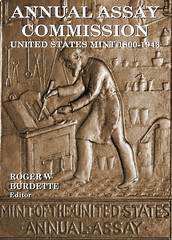 Author Roger Burdette pointed out a problem in my review of his new book,
Annual Assay Commission – United States Mint 1800-1943:
Author Roger Burdette pointed out a problem in my review of his new book,
Annual Assay Commission – United States Mint 1800-1943:
One minor mistake: "...Commission from 1800 through its final year of 1980." Should read "...through 1943." I omitted the final decades as there seemed to be little of interest in them. But several people have asked about adding these, so I may work on that as time permits.
But (American) football aside, Roger's work is now an essential part of my numismatic library - I expect to reference it again and again while reading up on multiple aspects of U.S. numismatic history, and I also fully expect that I'll encounter the title henceforth in the footnotes and bibliographies of most new books on U.S. numismatics.
From now on, all reviewers of books on U.S. numismatics should ask this question: "If the author didn't consult Burdette's Assay Commission records, why not?" Unless the author is an R.W. Julian or Roger Burdette who's spent countless hours researching in the Archives themselves, they'll have some explaining to do. -Editor
To read the earlier E-Sylum article, see: BOOK REVIEW: ANNUAL ASSAY COMMISSION – UNITED STATES MINT 1800-1943 (www.coinbooks.org/esylum_v13n49a07.html)
CONTENTS: THE SECRET HISTORY OF THE FIRST U.S. MINT
Whet it it did. The Index is a densely-packed two-page five-column affair indicating the breadth and depth of topics covered. It's too much to reproduce here, but below is a copy of the Table of Contents. I've already learned something (Frank H. Stewart's middle name), and I'm curious to see Frank H. Stewart purchases from Chapman Sales. -Editor
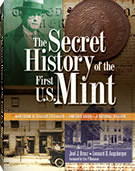
- About the Authors
- Dedication
- Foreword, by Eric P. Newman
- Preface
- Acknowledgments
- Introduction: The Declaration House: Foreshadowing of the First Mint's Fate
- Chapter 1: The Man, the Mint, and the Masterpieces
- Chapter 2: Frank Huling Stewart: The Man Who Owned the First United States Mint
- Chapter 3: “A Very Mean House”: The First United States Mint, 1792–1911
- Chapter 4: The Frank H. Stewart Collection: Relics of the First United States Mint
- Chapter 5: The Frank H. Stewart Collection: Coins Created at the First United States Mint
- Chapter 6: Frank H. Stewart's Commissioned Artworks: Edwin Lamasure's Cradle of Liberty and Ye Olde Mint
- Chapter 7: Frank H. Stewart's Commissioned Artworks: John Ward Dunsmore's Inspection of the First Dies and Washington Inspecting the First Money Coined by the United States
- Chapter 8: Artworks Inspired by Frank H. Stewart's Commissions: Frank J. Reilly's Director of the First U.S. Mint Inspecting Initial Coinage, Philadelphia, 1792 and Hy Hintermeister's Washington Examining the First Coins
- Chapter 9: The Fate of the Stewart Collection: Congress Hall, the National Park Service, and Rowan University
- Chapter 10: The Last Days of Frank H. Stewart
- Afterword: The Mint as It Was, the Mint as Stewart Fixed It in Memory
- Appendix A: The Stewartiana Catalog
- Appendix B: Frank H. Stewart Purchases From Chapman Sales
- Appendix C: Early Fire Insurance Surveys of the First Mint Campus
- Appendix D: Seventh Street Lot Numbering
- Appendix E: The Frank H. Stewart Photographs of the First Mint Demolition
- Notes
- Selected Bibliography (Focusing on Significant Numismatic References)
- Index
SPECIAL OFFER ON ADAMS BOOKS ON AMERICAN MEDALS
Bah, humbug. Not! Kolbe & Fanning are determined to brighten your holiday season with a special offer on three standard works on American medals written by John W. Adams. Any single title ordered by December 31st will be sold at 10% off the published price; any two titles will be sold at a 20% discount; and those ordering all three works will receive a 30% reduction on the total price. Details are available at: www.numislit.com. Happy Holidays!
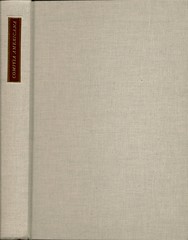

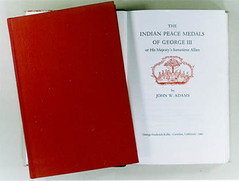
LAST CHANCE TO GET YOUR GETZ
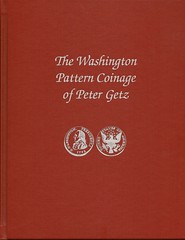 After December 31, 2010, copies of George Fuld's The Washington Pattern Coinage of Peter Getz will no longer be available for sale at the publication price.
After December 31, 2010, copies of George Fuld's The Washington Pattern Coinage of Peter Getz will no longer be available for sale at the publication price.
This new standard work comprises a meticulous census of all specimens known, accompanied by pedigrees, auction records, weights, diameters, condition, detailed descriptions, and other pertinent data. Copies were produced on a high quality laser printer and feature full-color enlargements of virtually all of the pieces described. Also included is a discussion of the real status of Baker 23, the unique Getz Large Eagle pattern. In addition, the story of the Washington ladle, which has a silver 1797 Getz Masonic medal, Baker 288, in its bowl, is documented for the first time in numismatic circles.
Until December 31, 2010, copies may be ordered from George Frederick Kolbe, P. O. Box 3100, Crestline, CA 92325-3100. Tel: (909) 338-6527; email: GFK@numislit.com.
The Spiral-Bound Edition is available until the end of the year by sending $100.00 per copy (payment by check or money order) to Kolbe.
The Cloth-Bound Edition is likewise available for $135.00 per copy.
Copies sent in the USA are postpaid; actual shipping will be charged for all other orders.
In January 2011, an up to date addenda to the book will be available online at www.numislit.com
MORE ON NUMISMATIC PUBLISHER AL HOCH AND THE COLONIAL NEWSLETTER
Al started The Colonial Newsletter in October, 1960, following the ANA convention in Boston. From the outset, the newsletter was printed, although the first two issues contained actual photographic plates which Al made at home. “This newsletter will not be sold,” he wrote. “It will be available to those of us who have the interest and willingness to make periodic contributions. The circulation of this newsletter will remain very small. However, with the interest of only a few more individuals this will become a useful medium of communication and an asset both to us and the science.”
Al published seven issues on a quarterly basis through April-June, 1962, then, after a hiatus of one year, turned the newsletter over to James C. Spilman who served as its editor and publisher for the next 34 years. The Colonial Newsletter is now published by the American Numismatic Society. It has become the journal of record on colonial and early American numismatics.
Al's original early issues of CNL are quite scarce. He told me that only 10 copies of the first and second issues were made. Under his brief editorship, contributions by Ken Bressett, A. R. “Del” Boudreau, Philip D. Greco, Walter Breen, Richard Picker, Thomas Ollive Mabbott, Edward R. Barnsley, Robert A. Vlack, George J. Fuld, T. V. Buttrey, Ted Craige and Spilman, among others, were published. Al's success in attracting leading collectors and researchers to his publication, and providing a forum in which new writers could participate, helped this field of numismatics to grow and thrive.
As for Quarterman Publications, Al said that many of his titles fell into the “labor of love” category, but the second edition of U. S. Civil War Store Cards by George and Melvin Fuld was a financial success. With Al's cooperation, several reprints of this edition were made for the benefit of the Civil War Token Society. The Society is now working on a third edition.
Al had a fine collection of Civil War tokens, some of which he sold directly to me and to other collectors. The balance of his collection was auctioned by the late Jack R. Detwiler in 1971.
Al was a generous person by nature. After we negotiated the contract for the Fuld catalog reprint, Al sent me gratis a copy of Quarterman's most ambitious project, the reprint of the British Museum's 1911 Medallic Illustrations in full size, with 183 superb annotated plates and 63 pages of indexes. Just out of the goodness of his heart.
Several years ago, I had arranged to have Al Hoch as our featured speaker at C4. With all his contributions to numismatics, I thought he'd have much to share and the guys would enjoy listening to him. That Friday afternoon at the convention, Al sought me out and found me. He apologized and told me he was going to have to cancel his talk because of medical issues. I was so disappointed but one's health should come first.
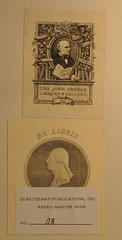 Al Hoch's company, Quarterman Publications, made the best reprints in the hobby. I wish they could have done more. My original Maris is the one Quarterman used to make all the reprints, and it has documentation inside. I was fortunate to purchase it from a friend at an Early American Coppers convention. It seemed a little pricey at the time, but I'm thrilled to have it.
Al Hoch's company, Quarterman Publications, made the best reprints in the hobby. I wish they could have done more. My original Maris is the one Quarterman used to make all the reprints, and it has documentation inside. I was fortunate to purchase it from a friend at an Early American Coppers convention. It seemed a little pricey at the time, but I'm thrilled to have it.
It has a bookplate from the John Crerer Library in Chicago, and a bookplate from Melvin & George Fuld, Baltimore MD. Pasted on top of the Fuld bookplate is a white label that states:
QUARTERMAN PUBLICATIONS, INC.
REPRO-MASTER BOOK
NO. 08
The "08" is written in by hand. So I assume that the Quarterman reproduction of the Maris NJ book was possibly the 8th in the series?
Ray adds:
Thanks also are due to Ray for providing images of various Maris editions for the NBS Bibliography. -Editor
To read the earlier E-Sylum article, see: CHARLES DAVIS: REMEMBRANCES OF AL HOCH (www.coinbooks.org/esylum_v13n49a02.html)
THE BOOK BAZARRE
SCOTT'S COIN COLLECTOR'S JOURNAL – A SURVEY
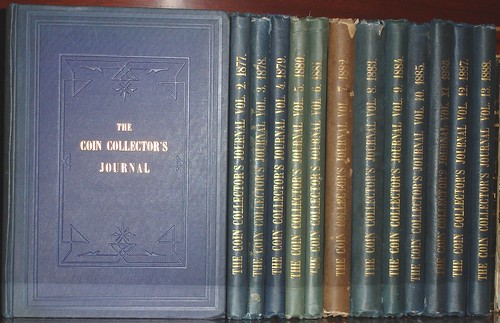
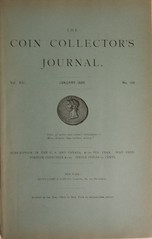 First I must apologize for the delay in writing this article. I thought this would be an easy article to write, with lots of interesting data, and the results may be interesting, but are not what I expected.
First I must apologize for the delay in writing this article. I thought this would be an easy article to write, with lots of interesting data, and the results may be interesting, but are not what I expected.
Well over a year ago, I surveyed readers about ownership of volumes of the early CCJs. I heard back from about a dozen members. I expected to hear what I've read, that all volumes of the early CCJ's are relatively common except for Volume 13 from 1887. I asked about what volumes were owned and how they were bound. In addition to the survey, I have fairly consistently tracked both eBay and Abebooks for the past two years, looking for additional volumes.
What did I find? The readers responding to my survey reported 5 complete bound sets, including my own, and one complete set in wraps. Yes, that's right… 6 total sets, plus another set missing 3 monthly issues of Volume 13. In addition, respondents reported about a dozen miscellaneous other volumes. On eBay and Abe I have seen maybe another dozen total volumes, including a combined Volume 8&9 on Abe. All of this equates to not enough information to draw statistically valid conclusions from, but I'll try anyway.
One interesting note was that there were two partial sets of loose monthly issues of Volume 13, one person had 9 monthly issues and the author has 11 loose issues.
In conclusion I spoke with George Kolbe and Charlie Davis about what they expected the numbers to be. George believed and Charlie concurred that there are likely about 25 complete sets extant. George also believes, but I'm not sure I agree, that there are sufficient copies of all volumes (including number 13) to put together another 25 sets.
From the sparse data gathered, and from my prior observations over the past decade or so, Volumes 1-4, are more common than other volumes but none are truly common. A further point would be that all original volumes in wraps are rarer than their bound counterparts.
Now that I've put this forth and created a nice target, all of you can now dig through your stacks, boxes and cases and send me info on all those miscellaneous volumes you didn't think were important before. If someone has access and inclination to search through university reference systems and see how many are impounded in rare book rooms at schools across the country, it would be informative.
Very best regards.
Leon Majors (h.majors@comcast.net)
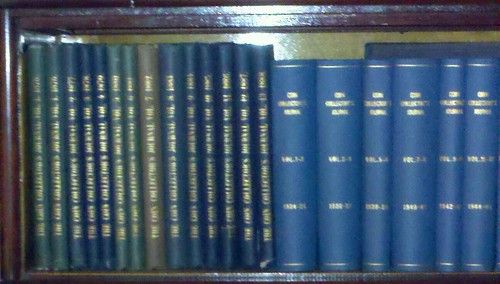
To read the earlier E-Sylum article, see: SURVEY: THE COIN COLLECTOR'S JOURNAL (www.coinbooks.org/esylum_v12n08a09.html)
TWENTY QUESTIONS INSPIRED BY MICHAEL POWILLS CORRESPONDENCE
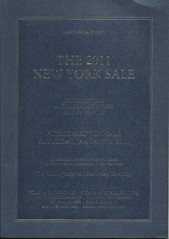 Long a popular parlor game in the United States, "Twenty Questions" became a successful radio quiz program in the 1940s and in the early 1950s it became a popular early television game show.
Long a popular parlor game in the United States, "Twenty Questions" became a successful radio quiz program in the 1940s and in the early 1950s it became a popular early television game show.
The version of the quiz presented here adheres to none of the original rules and is merely a device to induce E-Sylum readers to locate the answers, all of which are included in the description of lot 482 in the January 8, 2011 Kolbe and Fanning auction sale catalogue, accessible at www.numislit.com or in the mail to those on the Kolbe and Fanning mailing list.
Your compiler, George Kolbe, freely admits to shameful self-promotion, yet a modicum of "altruism" is also involved. The auction lot by its very nature appeals to a limited number of potential buyers, but its content is of interest to most any numismatic researcher or bibliophile. I had great fun writing the four page plus description and I think that many E-Sylum readers will have fun reading about the numismatic career of Chicagoan Michael Powills and his fascinating cast of characters.
Let the game begin.
1) Who was the leading numismatic literature dealer in mid-twentieth century America?
2) In the late 1930s, who handled the sale of duplicates from the Virgil Brand library?
3) Who had a 35 minute audience with King Farouk in Koubbeh palace in 1948, during which His Majesty expressed the desire to write articles for "The Numismatist"?
4) Which numismatist offered to "check into" King Farouk's "extensive collection of erotica" on behalf of the “Curator of the Institute for Sex Research, Inc. Founded by Alfred C. Kinsey”?
5) Who complained in 1947 of Frank Katen that "his britches are a little too tight for him right now"?
6) What was the policy of Frank Stewart that curtailed distribution of his 1924 book on the Philadelphia Mint?
7) Which American coin auctioneer was the exclusive distributor of Carl Würtzbach's "Massachusetts Colonial Silver" album in the late 1930s?
8) How long ago was Dick Johnson working on a "glossary of numismatic terms"?
9) Who took over William Hesslein's business after he absconded in 1932?
10) How much did it cost Ludger Gravel to publish the partial catalogue of his collection of historical medals?
11) Which numismatic bibliography author hoped that the American Numismatic Association would publish his work?
12) In 1946, who claimed to have the largest private collection of coins and money in the world?
13) Is M.H. Bolender's given name Milferd or Milford?
14) Who complained in 1949 about perceived impropriety in awarding the ANA auction contract to Abe Kosoff?
15) What prompted Frank Lapa to declare in 1973 that "I'm ready to take the deep 6…"?
16) Why are so many copies of John Ward's classic 1902 London work "Greek Coins and Their Parent Cities" found in the United States?
17) Which American coin dealer is quoted as having opined in 1929 about Virgil Brand's coin collection that "he would not hesitate to guarantee that he could realize by auction between two and a half and three and a half million dollars, and…he would not live long enough to see the fulfillment of the assignment!”?
18) Which subsequently convicted felon proposed the founding of the Professional International Numismatic Guild at the 1966 ANA Convention?
19) How many copies of Carothers' 1930 "Fractional Currency" were printed and did the author write it from an economic perspective or with coin collectors in mind?
20) Who, in the early 1930s, had “bought over 10,000 copies of ‘Numismatist' within the past year and sold three times as many as Duffield in that time…”?
To visit the Kolbe & Fanning web site, see: www.numislit.com
THE PHILADELPHIA MINT EXHIBIT OF THE LOUIS ELIASBERG COIN COLLECTION
I read with great interest the various comments about Louis E. Eliasberg, Sr., whom I was quite close to, as I indicated in earlier article concerning the H.R. Lee auction sale.
I think your readers should know more about Mr. Eliasberg. He was a prominent banker in the Baltimore area for over 50 years. One of his specialties was lending to the various distillers in the mid-Atlantic area monies to fund their products while they kept their products in bond. (this is during the aging period).
I remember he always liked to say to me, "Harvey, my boy." 'Lou', as I was allowed to call him, was a very dedicated collector. He knew that he had the good fortune to acquire the Clapp Collection, which set him on the way to his goal, to try to have a full collection.
I cannot tell you how he or we missed the 1866-S No Motto Double Eagle, except I believe that Clapp did not leave an empty hole in his album page, and everyone overlooked it. When one considers the great rarities and almost unique coins he acquired, an oversight of a "Date-Variety" can occur.
However, let's look at the man. He was proud of what he had, and did not hesitate to show it when collectors came visiting. He was always willing to learn, and we the Stack Family endeavored to keep him informed and up-to-date.
He, as a banker, who served on numerous boards in the Baltimore area, showed his collection to the public often. I remember when he had a display in the vast lobby of the Baltimore National Bank in 1951. He left it on display for a period of several months, then returned the collection to the vaults.
Every few years, in order to expose the collection to the collectors, as well as the depositors, of various banks, he allowed the collection to be displayed in special rooms in the displaying banks.
Louis E. Eliasberg, Sr., was an active collector and was known to belong to many coin clubs in the Baltimore Area, and he usually displayed a few rarities to excite the viewing collectors. He often permitted the coins he showed to be passed among the viewers so they could always say that they HAD HELD this rarity or that rarity THEMSELVES!
As I related in an earlier article in The E-Sylum, he did dispose of some of his duplicates at auction through our company. He did not wish to have the Eliasberg name attached to the sale, so the H. R. LEE COLLECTION label was used.
But let's now get to the story of the Bicentennial Exhibit at the Philadelphia Mint during the celebration in 1976 and sometime after.
As the years had gone by since Lou acquired the Clapp collection and continued to complete it, by early 1970 he thought about what would happen to the collection after he passed away. I remember visiting him in 1970 when he set forth a sales idea for his collection. HIS DESIRE AT THAT TIME WAS TO KEEP IT INTACT.
He formulated a plan, which to us was quite unique for the hobby. It was common in that period,(as it was done often for the previous three decades) to take great collections and show them about the country. How did many get shown? The exhibitor would engage a group of railroad cars, set up the collection in a vibrant display, park the train in railroad stations, for weeks at a time, and invite the public to view it.
His method of showing the collection was unique in its own way. As he did in banks earlier, he had developed display frames, with glass on both sides, so collectors could view each coin for date, and mint mark where applicable. These frames were set up in vertical steel racks of 10 to 15 frames working like a ROLODEX that could be rotated. Full series were so displayed. It was a remarkable way to show the coins, and those who came to see them, were excited and pleased to be able to view this collection in this manner.
Realizing after he conceived this great idea for show, he approached many houses on Wall Street as well as large corporations to show the collection with their support and that these corporations could use THEIR NAME as an advertising vehicle. THEN, after a two or three year display about the country, he would have some Wall Street House to Incorporate the collection, SELL SHARES AND TAKE THE COLLECTION PUBLIC, so it could remain INTACT for the future. WOW, what an IDEA ! Now you know what made him so successful in business.
Unfortunately, the economic conditions in the early 1970'S were not great, and the idea did not fly. It was taken off the market in 1973 or early 1974, so the Louis E. Eliasberg could think of how HE could keep the collection intact.
Now we have to switch locations of discussion. In 1974 the U.S. Mint was building a new building to house a brand new facility in Philadelphia. They wanted not only to show how coins were made, but wanted to make a exhibit of their earlier products: coins and medals.
As the Mint, starting near the beginning of the 20th Century housed many of its coins in the Smithsonian Institution, where they were put on display for all to see. The mint asked the then curators of the National Numismatic Collection to return the coins that were "loaned" the Smithsonian.
The curators at the time were Vladimir and Elvira Clain-Stefanelli. They were horrified by the request. THEY HAD PLANNED TO EXHIBIT A GOODLY NUMBER OF THE COINS AT THE SMITHSONIAN IN WASHINGTON during the bicentennial. The work they did before the request was received included a massive display of the same coins. After all, they had showed them and used them in displays for many years, and they expected to be able to show them together with the other coins in the Smithsonian during the Bicentennial Celebration. Only they wanted the coins shown in the Museum of American History in Washington, D.C.
As the Stefanellis were great friends of the entire Stack Family (they worked for us in the 1950's), they came to us with the problem in hand. I remembered the idea that Louis E. Eliasberg was thinking of, to expose HIS COLLECTION nationwide. I thought, what if we could convince Lou to show his collection at the Mint in Philadelphia? So Norman and I went to Baltimore to propose the idea to him. At the time he was not well, and our visit was welcomed as old friends who helped each others for well over three decades. He smiled, puffed on his cigar, and turned to me and said, 'MY BOY, THAT IS A GREAT IDEA' "Do you think it can be done.?
The Stack Family had made friends through the years at various government agencies, and we called on the many we knew to propose the idea to the Mint. Those we knew all thought that the idea was a great diplomatic solution to a very touchy problem. (A few years earlier besides helping the government show the Truman Library Collection we worked on various projects with the Mint).
There was an Assistant Director at the Mint offices in Washington, D.C. who was recommended to us . The members of the Stack Family put their heads together, thought how to approach the Mint and I pleaded the case to the Mint Representatives. A similar approach was done by the Smithsonian officials. To release back to the Mint all the coins they wanted could start a great debate between the Smithsonian and the Mint. The idea went forward.
At that point, Louis E. Eliasberg, Jr., who through the years worked closely with his father when exhibits had to be made, was given the job of negotiation with the Mint. Louis Sr.'s health did not permit him to do the negotiations himself.
Louis Jr., was somewhat of a flamboyant person - strong negotiator and always looking to please his father's wishes when deals had to be made. Well, all went well, except for one item. It had been agreed that the Mint would send their armored trucks to Baltimore to pick up the collection and provide chase cars before and after the trucks to further protect the transportation of the collection.
Louis Jr. felt he wanted to show how much he was concerned with the transportation and setting up of the collection. He wanted to be part of the ESCORT detail to follow the collection in one of the "chase cars". Though this was not common for a non-government person to ride in a security government vehicle, the Mint officials decided to break the procedure and agreed.
But that didn't satisfy Louis Jr. He asked that the Mint Officials get him a federal arms permit so he could travel interstate with his own gun. This really was breaking the Mint's protocol. Never done before! Well, he responded, YOU'LL NEVER DISPLAY THE ELIASBERG COLLECTION! After a call to the Division of Federal Firearms, a concession was made, and he rode shotgun while moving his father's collection.
The collection was shipped in early 1976 and was received at the Mint the same day. Waiting to receive it was a group of mint officials and myself. I was there to help the exhibit be assembled and placed on a huge balcony overlooking the gigantic lobby entrances to the Mint.
Louis Jr. was so headstrong and wishing to boast to his father that HE was put in charge of setting up the displays, and he made a point that those who were there to help him, including myself, weren't really needed (of course he was wrong, as some of the panels were put out of order, and if I wasn't there, they would be difficult to find during the exhibit).
Louis Jr.'s character during the assembly of the collection, that he personally sealed the display cases, with special seals on the special racks that would hold them! He actually had a special seal made to insure that they weren't tampered with. With the amount of guards the Mint provided about the display, it could never happen. But Louis Jr. was so paranoid that we all gave in to his whims.
The collection was on display for several years during the BICENTENNIAL CELEBRATION, was viewed by many millions of visitors, and was a major attraction!
Having been there myself, watching all this happen, let me say without contradiction, that the ELIASBERG COLLECTION was on full display at the MINT in PHILADELPHIA during our country's great BICENTENNIAL CELEBRATION.
I am extremely proud to have been a part of making it happen. Unfortunately, Louis E. Eliasberg, Sr., the developer of the collection, never had the pleasure to see the display at the Mint during the Bicentennial because of ill health. He would have surely been a proud man!
THE BOOK BAZARRE
“History of the United States Mint and Its Coinage.”FRED LAKE ON HARRY X BOOSEL
Fred Lake writes:
I first met Harry in 1988 and visited him in Chicago when I was asked to pick up his "Redbook" collection and offer it for sale. You can see what I had offered in Function Associates Premier Sale of Numismatic Literature dated May 17,1989.
Harry took me to his basement and we dug around in old Army foot lockers to find the books. Harry said that he did have a First Edition, but we never did get to the last trunk which was buried under a ton or two of other stuff.
He was a very witty guy in a "dry" way and I fondly remember my visit with him.
QUIZ ANSWER: JENNY LIND, THE SWEDISH NIGHTINGALE
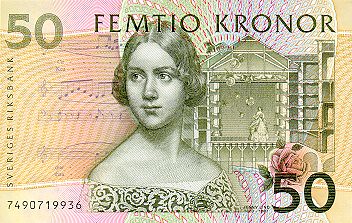
Last week I wrote:
The artist on this Swedish 50 Kronor note was a singer. Who was she, and what was her connection to U.S. numismatics?
Pete Smith was the firstest with the bestest answer. He replied before midnight Sunday. But first, here's what other readers had to say.
Jim Duncan of New Zealand writes:
I think she's Jenny Lind, but as a kiwi I haven't a clue on her connection, unless she was the collector.
Mike Marotta writes:
The 50-kronor note from Sweden features Jenny Lind. My co-author Ann M. Zakelj, gave me one of these when she returned from one of her many visits to Europe. A couple of weeks later, at the Curious Bookshop in East Lansing, I found Jenny Lind: Songbird from Sweden by Elisabeth P. Myers (Champaign, Illinois: Garrard, 1968); and now the note (in a mylar sleeve) is with the book.
Searching the Internet revealed a second somewhat tangential numismatic reference. "The Songbird and the Huckster," (The Washington Post, February 4, 2002) tells of an performance by the Library of Congress, Libby Larsen's Barnum's Bird (a Choral Opera). See http://www.highbeam.com/doc/1P2-323047.html
Bob Evans writes:
The subject of the 50 Kronor note is Jenny Lind, the "Swedish Nightingale." Johanna Maria Lind was a very popular operatic soprano of the mid-nineteenth century. I'm not quite sure what the connection to U.S. numismatics is, but I will give it a shot with two somewhat oblique connections.
In 1850 she embarked on an extraordinarily popular tour of the eastern United States, a series of concerts organized by P. T. Barnum. There is a medal, made by Allen & Moore of Birmingham, England, that was probably sold in the U.S. in conjunction with the Barnum tour.
As well, there is a Jenny Lind, California, a village on the road from Sacramento to Stockton, that saw active placer mining during the Gold Rush. I'm certain that some of that gold ended up in circulating U.S. coins.
Mack Martin was thinking along similar lines:
I think the artist on this Swedish 50 Kronor note is Johanna Maria Lind (6 October 1820 – 2 November 1887). She toured America (1850) doing concerts. The gold-rush town of Jenny Lind, California the named after her.
Patrick McMahon, Director of Exhibitions and Design at the Museum of Fine Arts, Boston writes:
I'm sure you'll get all sorts of answers about the numismatic link to Jenny Lind. We don't have any examples of the tokens and game counters at the MFA, but we do have a French fan from 1850 that shows several images of her—one of which is strikingly similar to the one on the Kroner. So I thought I'd share.

To read the complete collection entry, see: (www.mfa.org/collections/object/fan-124623)
Joe Boling writes:
A female singer on a Swedish note has to be Jenny Lind, "The Swedish Nightingale." (Yup - I just looked it up in the Standard Catalog of World Paper Money - it's number 62 in the Modern Issues volume, same portrait continued on number 64 with more security features). And of course, she's also identified at the cited website.
Pete Smith writes:
Leonidas Westervelt compiled a list of Jenny Lind tokens and medals published by the American Numismatic Society in 1921 as No. 5 in their series Numismatic Notes and Monographs. This monograph does not mention the Swedish 50 kronor note. At one time I thought about collecting Jenny Lind medals but the topic was too large and availability too small so I abandoned my quest.
To read the earlier E-Sylum article, see: FEATURED WEB PAGE: ARTISTS ON BANKNOTES (www.coinbooks.org/esylum_v13n49a20.html)
FOLLOW-UP: SABINE PASS MEDAL COPIES
Jonathan Brecher writes:
Regarding the Sabine Pass medal from a couple of weeks ago, the official answer in terms of value appears to be "Not Much". An identical replica just ended on eBay, with no bidders willing to match even the measly $9.00 opening bid: cgi.ebay.com/ws/eBayISAPI.dll?ViewItem&item=170576527352. That listing was described more or less correctly, and listed in a reasonable category, so I guess that's that.


Lloyd Wagner example
To read the earlier E-Sylum article, see: MORE ON SABINE PASS MEDAL COPIES (www.coinbooks.org/esylum_v13n49a15.html)
THREE STANDARD WORKS ON AMERICAN MEDALS
BY JOHN W. ADAMS
THE INDIAN PEACE MEDALS OF GEORGE III
COMITIA AMERICANA AND RELATED MEDALS
MEDALLIC PORTRAITS OF ADMIRAL VERNON
SPECIAL HOLIDAY OFFER
For Details Visit Our Web Site:
www.numislit.com
KOLBE & FANNING NUMISMATIC BOOKSELLERS
141 W JOHNSTOWN ROAD, GAHANNA OH 43230-2700
(614) 414-0855 •
df@numislit.com
•
GFK@numislit.com
MORE ON THE TRUMAN LIBRARY COIN COLLECTION
Harry Waterson writes:
I found this picture on the Truman Library website. There are 9 more in their online photo collection. See www.trumanlibrary.org/photographs/index.php. This should give you the photos search page. I used 'coin collection' to find the photo.
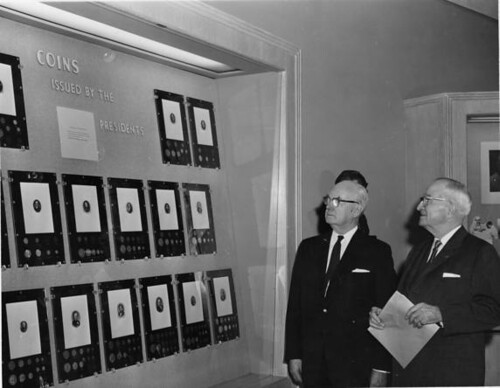
To read the earlier E-Sylum article, see: THE STORY OF THE TRUMAN LIBRARY COLLECTION (www.coinbooks.org/esylum_v13n49a10.html)
MORE ON COUNTERFEITED 1910 20-MARK REICHSBANKOTES
Last week Joe Boling wrote:
On Whitman's "Vault" books, they also did World War II: Saving the Reality, A Collector's Vault. It has an egregious numismatic error on page 56, where it shows two 20-mark notes, one allegedly a British forgery of the German original - dated 1910. Those notes were wiped out by the 1923 hyperinflation, and would never have been a subject of British forgery in WWII (and as far as in know, were not such a subject during WWI, either).
Publisher Dennis Tucker followed up this week with Joe and Herb Friedman, upon whose research the book's information was based.
Herb Friedman wrote:
My main source was Murray Teigh Bloom who was a close friend and specialist on Counterfeiting and traveled the world interviewing the old counterfeiters, banks and government officials. The problem seems to be that you think it was for WWII. It was for WWI and the note was only a few years old then.
Herb included the text of an article he'd written on the notes (see below). Joe Boling responded:
I was commenting on the fact that the note is in a book on WWII, and obviously was not in use during that period. Rather than the note, any of the stamps that the British produced for WWII would be good subjects to place on this page (they already have a 1941 ration book and 1944 ration stamps).
Dennis Tucker responded:
The Reichsbankotes (genuine and forged) are pictured in the section of the book that discusses black propaganda. They're used as general illustrations of government-forged currency, and not necessarily meant to represent notes of WWII vintage. However, I can see how that might need clarification, so in our next print run we'll add a sentence explaining that the pictured notes are examples of British forgeries from an earlier generation.
To read Herb Friedman's article, see: British Forgeries of the Stamps and Banknotes of the Central Powers (www.psywarrior.com/BritishForgeriesWWI.html)
To read the earlier E-Sylum article, see: NOTES FROM E-SYLUM READERS: DECEMBER 5, 2010 (www.coinbooks.org/esylum_v13n49a16.html)
THE BOOK BAZARRE
GREEN [SPACE] DUCK WAS ORIGINALLY GREENDUCK CORPORATION
 The query in last week's E-Sylum about a GDC mintmark was answered correctly by editor Wayne Homren. But there is more to the story.
The query in last week's E-Sylum about a GDC mintmark was answered correctly by editor Wayne Homren. But there is more to the story.
The company with the funny name was founded in 1906 by two Chicago men. One was George G. Greenburg (formerly with Chicago diesinking firm Childs & Company). The other was Harvey Ducgheisel (probably of German nationality). For their new firm they chose the name "Greenduck" as how the first syllable of each of their last names were spoken. They had intended the name to be one word but so many people used it as two words that the company itself adopted that form, ultimately to become Green Duck Metal Stamping Company.
And metal stamping they did. Their products list was boundless, including many of numismatic interest. They made the American Numismatic Association's convention badge for the Cleveland ANA Convention in 1954 and the Chicago ANA Convention of 1955. They struck campaign medals, lots of tokens, medals, badges, so-called dollars, and watchfobs -- right from the very start -- adding Mardi Gras doubloons and casino chips in their later years.
But their specialty was pinback buttons among a wide assortment of products, often lithographed in color. These included buttons, tabs, label buttons, book marks, small advertising signs, crickets, key tags, fare tokens, arcade tokens, on and on. In fact a 1930s advertisement listed 48 such products. Early on they even struck Illinois state license plates, and, souvenir spoons for the 1934 Chicago World's Fair.
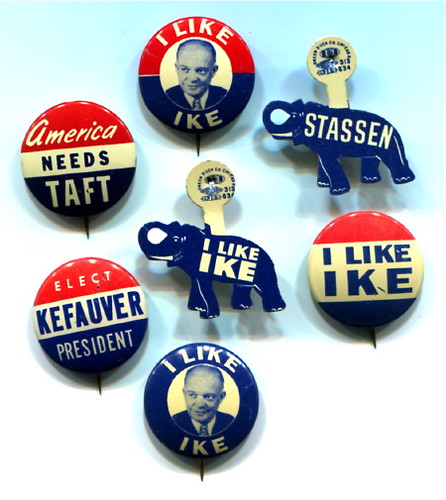
The company changed ownership and moved from Chicago to Hernando, Mississippi in 1962. It was here they struck Mardi Gras doubloons and, in 1983, their first casino chip. The firm changed ownership again but could not sustain operations and went out of business in 2004.
Green Duck items are well known to collectors, particularly to the customers of Hakes Americana & Collectibles which frequently offers Green Duck buttons as collectors' items. The firm, headed by Ted Hake, featured the company's button archives -- consigned by a Chicago collector -- in a January 19-20, 2010 auction sale.
For collectors of numismatic items I have attempted to list all those diestruck items made by the firm for my databank on American artists, engravers, diesinkers and medallists. The entry on Green Duck occupies six pages.
To read the earlier E-Sylum article, see: QUERY: GDC CASINO TOKEN MINT MARK (www.coinbooks.org/esylum_v13n49a12.html)
NOTES FROM E-SYLUM SUBSCRIBERS: DECEMBER 12, 2010
Ginger Rapsus writes:
I was very interested in the comments on the wonderful world of AOL. I am no computer expert, but I want to switch providers too.
Dick Johnson forwarded the following note from his son. An upcoming PBS documentary includes some footage relating to Coin World.
Check your local PBS listings starting December 14 for the series Independent Lens. It will show the documentary about Sidney, Ohio, 45365.
http://www.pbs.org/independentlens/
http://www.pbs.org/independentlens/45365/
http://www.pbs.org/independentlens/broadcast.html
Joe Boling writes:
Noting the article about the new Kansas City Federal Reserve Bank museum in Denver, I realized that nothing has been said in The E-Sylum about the extension of the New York Fed's counterfeit paper money exhibit. It will now be open through the end of January, so anyone going to the NYINC has a chance to take in the exhibit. I will be taking advantage of the opportunity. Go to www.newyorkfed.org for information about visiting the bank.
Joe adds:
Do we know who wrote Al Hoch's obituary? It certainly sounds like somebody close to numismatics.
I don't, but perhaps one of our readers does. Joe also noted an omission in the last's issue. He writes:
You didn't say who sent in the suggestion for Dave Bowers' wire recording transcribing (somebody named Tim, apparently).
It was Tim Shuck. Sorry!
WAYNE'S NUMISMATIC DIARY: DECEMBER 12, 2010
I usually check my personal email account before leaving the house for work. Waiting for me Monday morning was a note from Jim Duncan in New Zealand. There was also a deluge of other E-Sylum email. Several folks had forwarded articles on the BEP's continuing problems with the new $100 bill, and a number of readers responded to the Jenny Lind quiz question.
Jim's email had the subject line "Songbird". That really struck me because only minutes before I'd called my daughter Hannah a "songbird". She was tying her shoes getting ready to leave for school, and singing a little song to herself. Hannah was born with a song in her heart. She often sings, sometimes even singing herself to sleep and waking up in the morning with another song.
Last year when the two of us were home alone one weekend afternoon she wanted to play "talent show". She made up a song and dance routine on the spot, and played it to the hilt. She lounged on a kid-sized table like a pint-sized Michele Pfeiffer on the baby grand piano in The Fabulous Baker Boys. She walked over and high-fived me, all while continuing to belt out her song. Five years old, and she's WORKING THE CROWD. Where does this stuff COME from? Anybody know a talent scout?
On Tuesday I began sweating when I learned that BOTH of my helpers for the kids' event at the upcoming Annandale Coin Show would be unable to come. Not a problem ordinarily, but my wife Dee had mentioned having plans for Saturday morning, and I was wondering if even I would be able to make it. But luckily it worked out - she was planning to take the kids with her and I'd be free to go to the show.
When Wednesday arrived I left work early to return home to pick up Dee. We were going to the holiday dinner for Nummis Nova, my Northern Virginia numismatic social group. It was at a restaurant called Marco Polo's in Vienna, VA. We saw a number of nice Christmas light displays along the way from our house.
We had a separate room for our group, and it was pretty spacious. Three round tables were set up. We found seats at a table with Chris Neuzil, Howard and Phung Daniel and Jon Radel, one of my kids' program helpers. Later Julian and Fran Leidman joined us.
At a nearby table were Joe and Alice Levine, Dave and Joannne Schenkman, and Gene Brandenburg and his wife Amelia. The third table had Roger Burdette, Dick Doty, Mike Packard, Brian Cushing, and Wayne and Karin Herndon.
Although the facility was pretty nice the service was SLOOOOOOOOOW. But the upside to that was having plenty of time to talk and trade stories. The restaurant name reminded Chris of a news story. Police were called to a reported break-in at a warehouse. Two cops arrived and sure enough, a door had been broken into. Once inside, they saw that the darkened warehouse was HUGE, and wondered how they could ever find the crooks. Then one of the cops yelled "Marco!" and another voice called out, "Polo!" (If you don't get it, you need to know about the children's game called Marco Polo, usually played in a swimming pool).
For entertainment I'd prepared a holiday quiz with questions I'd found on the Internet, like "How to you say Merry Christmas in Spanish?" and "How many la's are there in a line of "Deck the Halls"? It was fun. I was inspired by Don Carlucci, who'd always prepared something like this for the holiday dinners at Sphinx in Pittsburgh, the club I'd modeled our group after.
Karin Herndon told my wife how great I was working with the kids at the coin shows, and Dee wondered "So why can't he help our kids with their homework?" I thought, "Because every time I do, you butt in, tell me I'm doing it all wrong, and call me an idiot..." I didn't say that, though. I may actually BE an idiot, but I know what's good for me.
Roger delivered copies of his new Assay Commission DVD set to Joe Levine and other purchasers. It was about 10pm by the time we all got our checks and could head home. It had been a great evening.
My next numismatic event was unexpected. While driving to work Friday morning National Public Radio aired an interesting segment about Yap Stone Money (see the separate article in this issue for a long excerpt).
Instead of working on The E-Sylum Friday night, I prepared a set of slides on collecting U.S. Type coins for Saturday's kids event. I had earlier visited Wayne Herndon's office to prepare the auction lots and bidding envelopes. I finished about midnight and called it a night.
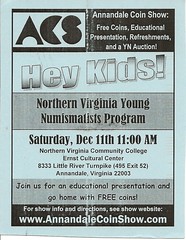 Saturday went well. I arrived early to prepare the room and lay out the auction lots. As 11am approached kids and parents began to arrive. I asked one of the parents who'd come a number of times to help out, and he gladly accepted, taking over the registration table for me. In the end we had twelve kids, including three girls, with about 25 people in the room. My talk was on collecting U.S. type coins. The auction afterwards was fun, and I think everyone came away happy.
Saturday went well. I arrived early to prepare the room and lay out the auction lots. As 11am approached kids and parents began to arrive. I asked one of the parents who'd come a number of times to help out, and he gladly accepted, taking over the registration table for me. In the end we had twelve kids, including three girls, with about 25 people in the room. My talk was on collecting U.S. type coins. The auction afterwards was fun, and I think everyone came away happy.
I took a couple minutes to walk around the bourse floor. I noticed one dealer's table had a sign that read, "You wife called. She said you can buy anything you want." I ran into Bill and Susan Eckberg and we chatted for a while. Bill showed me a nice red 1951 Lincoln cent he'd purchase to upgrade his set.
On the drive home I called Don Carlucci in Pittsburgh to talk about the upcoming election of officers of the Pennsylvania Association of Numismatists (PAN). He was visiting the coin shop of Ed Narcisi, a former member of Sphinx. The society had their holiday dinner the same night I'd had mine in Virginia, and they also took one of Don's holiday quizzes.
I got stuck in traffic on the beltway and passed a nasty accident - a van was tipped over on its side. I guess it was a good thing I lingered a bit at the show. When I got home at 2pm I was just in time to hop into Dee's van to take our sons to their basketball game. They played great. Tyler scored the first basket, putting their team ahead. They stayed in the lead most of the game, but their opponents caught up and went 1 point ahead late in the 4th period. Christopher scored the winning basket and Tyler made a rebound to run out the remaining seconds. They won by 1 point, 24-23. Whew!
After dinner Saturday night I opened my mail and found a copy of the new edition of Scott Travers' book, The Coin Collectors' Survival Manual. Donn Pearlman had sent it. No time to read, though. After the kids went to bed I worked on The E-Sylum for a while. It had been a good week.
JANUARY 8, 2011 NEW YORK AUCTION SALE HIGHLIGHTS
The Superb Latin American Numismatic LibraryFormed by Alan Luedeking
Including: Virtually Complete Sets of Specialized Auction Sale Catalogues
on the Topic; Sets of Specialized Periodicals; David Henkle's Checklists
of Latin American and Caribbean Tokens; Twenty Medina Works Including
All the Key Titles; Original Rubbings of the Howard Gibbs West Indies
Collection; Rare Works by Burzio, Meili, Rosa et al.
Part Two of the Alan Luedeking Library Will be Offered
in Spring 2011
141 W JOHNSTOWN ROAD, GAHANNA OH 43230-2700
(614) 414-0855 • df@numislit.com • GFK@numislit.com
MORE ON THE 1962 SEATTLE WORLD'S FAIR MILLION SILVER DOLLAR EXHIBIT
One of the many committees working on the 1962, six-month-long, Seattle World's Fair, which would live on in the Space Needle and Monorail, was responsible for producing, promoting and selling souvenir medals for the exposition. The committee, with Northwest Historic Medals, was also charged with producing a venue for medal sales and was thus attracted to an advertisement for Behlen buildings. The committee also conceived of the display of a million silver dollars to attract medal purchasers and thus contacted Gerry Joseph, Behlen's sales manager, to see if they might be interested in a package promotion.
The downside for the promoter was the loss of the interest on half a year's earnings on the million dollars, then about 6% a year. This would however also amount to a plus for the U. S. Treasury who figured to gain an estimated $167 a day in earned interest.
Behlen calculated that silver dollars could be obtained at either the Denver or Philadelphia mint with their total cost of building the structure, displays and transporting the dollars, would be about $50,000 but could easily be worth that much in advertising alone, particularly if they could sell some of the display.
With the fair's April 21 opening fast approaching, the decision to proceed was made and arrangements initiated to purchase the silver dollars from the Federal Reserve Bank in Philadelphia and take delivery at the U. S. Mint there rather than Denver making the transportation across the country part of the promotion of the fair as well as the Behlen Company. Hartford Insurance Company's bid of only $300 to insure the transportation beat Lloyd's of London, clearing the way for the physical move.
At first it was planned to use their own trucks but General Motors, also seeing the advertising potential, donated two Chevrolet diesel trucks and two Cadillac escort vehicles while Trailmobile Co. loaned them two cargo truck bodies. On April 2, 1962 the trucks backed up to the mint to load the nearly 30 ton cargo. $500,000 of canvas bags, each with 1,000 silver dollars were loaded into steel boxes bolted to the floor of each truck in three hours.
The convoy then set out with police escorts through towns and state patrol cars on highways while Pinkerton agents were scattered through the various vehicles. All expenses during the 13 day trip were paid for with silver dollars, often under the watchful eyes of the local press which, along with the billboard-like trucks, generated publicity in their wake.
As soon as they reached Seattle, silver dollars were purchased from local banks to replenish those paid out along the way. Meanwhile the building had been completed with a seven foot diameter, five foot high Behlen corn crib inside. The crib was then covered with mesh and 800,000 Morgan silver dollars, which had been sealed in $1,000 bags at the mint between 1910 and 1915, were stacked inside the crib. Then 200,000 1922 Peace dollars were poured loose over the bags and into a three inch gap between the crib and the bags. The mesh screen was then removed allowing some of the loose dollars to spill out giving the effect of a loose pile of 1,000,000 silver dollars.
Ten different medals were sold at the display including one which depicted two pyramids of silver dollars and the space needle. Three medals were also minted in 14-kt gold, two at the U. S. Mint and one by Medal Arts Co. In June a young lady from California was awarded $100 silver dollars for being the millionth visitor to the display. In addition to selling official medals, visitors were offered bags of silver dollars for $1,500 with delivery after the fair closed.
To read the complete article, see:
Jim McKee: Walt Behlen's other million dollar idea
(journalstar.com/news/state-and-regional/nebraska/
article_eb9815a9-79fe-5aa3-ad0f-7dbe9a8d0466.html)
To read the earlier E-Sylum article, see: 1962 SEATTLE WORLD'S FAIR MILLION SILVER DOLLAR EXHIBIT (www.coinbooks.org/esylum_v10n49a14.html)
CONTINUED PROBLEMS WITH THE NEW $100 BILL
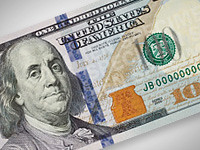 A significant production problem with new high-tech $100 bills has caused government printers to shut down production of the new notes and to quarantine more than one billion of the bills in huge vaults in Fort Worth, Texas and Washington, DC, CNBC has learned.
A significant production problem with new high-tech $100 bills has caused government printers to shut down production of the new notes and to quarantine more than one billion of the bills in huge vaults in Fort Worth, Texas and Washington, DC, CNBC has learned.
Initially scheduled for release in February of 2011, the new bills were announced with great fanfare by officials at the Treasury Department and the Federal Reserve in April.
At the time, officials announced the new bills would incorporate sophisticated high-tech security features, including a 3-D security strip and a color-shifting image of a bell designed to foil counterfeiters.
But the production process is so complex, it has instead foiled the government printers tasked with producing billions of the new notes.
An official familiar with the situation told CNBC that 1.1 billion of the new bills have been printed, but they are unusable because of a creasing problem in which paper folds over during production, revealing a blank unlinked portion of the bill face.
A second person familiar with the situation said that at the height of the problem, as many as 30 percent of the bills rolling off the printing press included the flaw, leading to the production shut down.
The total face value of the unusable bills, $110 billion, represents more than ten percent of the entire supply of US currency on the planet, which a government source said is $930 billion in banknotes. For now, the unusable bills are stored in the vaults in "cash packs" of four bundles of 4,000 each, with each pack containing 16,000 bills.
Officials don't know exactly what caused the problem. "There is something drastically wrong here," a person familiar with the situation said. "The frustration level is off the charts."
Because officials don't know how many of the 1.1 billion bills include the flaw, they have to hold them in the massive vaults until they are able to develop a mechanized system that can sort out the usable bills from the defects.
Sorting such a huge quantity of bills by hand, the officials estimate, could take between 20 and 30 years. Using a mechanized system, they think they could sort the massive pile of bills, each of which features the familiar image of Benjamin Franklin on the face, in about one year.
The defective bills—which could number into the tens of millions, potentially representing billions of dollars in face value—will have to be shredded. American taxpayers have already spent an enormous amount of money to print the bills.
According to a person familiar with the matter, the bills are the most costly ever produced, with a per-note cost of about 12 cents—twice the cost of a conventional bill. That means the government spent about $120 million to produce bills it can't use. On top of that, it is not yet clear how much more it will cost to sort the existing horde of hundred dollar bills.
After they were printed, officials discovered that some of the new bills have a vertical crease that, when the sides of the bill are pulled, unfolds and reveals a blank space on the face of the bill. At first glance, the bills appear completely printed, but they are not.
Officials have mixed views on what caused the problem, and who is responsible for it. "This is not about assigning blame," said one. But another person familiar with the matter said finger-pointing has already begun. "The Fed's very unhappy, and the Bureau of Engraving and Printing is taking a beating unnecessarily," the person said. "Somebody has to pay for this."
To read the complete article, see: The Fed Has a $110 Billion Problem with New Benjamins (www.cnbc.com/id/40521684)
To read the complete article, see:
Updated $100 Bills May Be Too Tough To Print
(www.npr.org/2010/12/07/131884481/New-100-
Bills-May-Be-Too-Tough-To-Print)
E. Tomlinson Fort adds:
A few weeks ago we had a debate as to whether or not the Unites States should keep producing one cent coins. Now, here is the other side of the denomination scale, an essay on why we should abandon the $100 note.
The United States government is having a little trouble printing up its newly designed $100 bills. More than 1 billion of these new Benjamins are unusable because they crease in the presses, leaving blank spots on the final product. It's an amusing minor story whose true significance has been missed. Why does the world need 1 billion $100 bills? Indeed, why does the U.S. continue to print C-notes at all?
In May 1976, an economist named James Henry published a wonderful essay in the Washington Monthly titled "Calling in the Big Bills." In it, he observed that "only two kinds of activities in the U.S." required the use of large-denomination currency. One was tax evasion, and the other was organized crime. Henry might also have added certain legal but morally dubious needs, like a compulsive gambler's need to hide his addiction from his family or a billionaire braggart's need to light his cigar with a flaming C-note (though the latter type is probably a creature of myth). In his 1976 piece, Henry proposed that the Treasury and Federal Reserve call in all bills of $50 or more and require holders to exchange them in banks for $10 and $20 bills.
Thirty-four years of inflation make Henry's inclusion of $50 bills seem perhaps overzealous, but, otherwise, his argument has become more compelling, not less.
To read the complete article, see: Ban the Benjamins! (www.slate.com/id/2277404/)
YAP: THE ISLAND OF STONE MONEY
 There's a tiny island called Yap out in the Pacific Ocean. Economists love it because it helps answer this really basic question: What is money?
There's a tiny island called Yap out in the Pacific Ocean. Economists love it because it helps answer this really basic question: What is money?
There's no gold or silver on Yap. But hundreds of years ago, explorers from Yap found limestone deposits on an island hundreds of miles away. And they carved this limestone into huge stone discs, which they brought back across the sea on their small bamboo boats.
It's unclear if these stones started as money. But at some point the people on Yap realized what most societies realize. They needed something that everyone agrees you can use to pay for stuff.
And like many societies, the people of Yap took the thing they had that was pretty — their version of gold — and decided that was money.
A piece of stone money was really valuable; you wouldn't use it for some everyday purchase. You'd use it for something big — a daughter's dowry, say.
"If somebody was in real dire straits, and something happened to their crop of food or they were running low on provisions and they had some stone money, they might trade," says Scott Fitzpatrick, an anthropologist at North Carolina State University who is an expert on Yap.
One key thing about this money: It was really heavy. A big piece could weigh more than a car.
As a result, this very concrete form of money quickly made the jump to being something very abstract.
"They often talk about the stones themselves not changing hands at all," Fitzpatrick says. "In fact, most of the time they wouldn't."
So imagine there's this great big stone disc sitting in a village. One person gives it to another person. But the stone doesn't move. It's just that everybody in the village knows the stone now has a new owner.
In fact, the stone doesn't even need to be on the island to count as money.
One time, according to the island's oral tradition, a work crew was bringing was bringing a giant stone coin back to yap on a boat. And just before they got back to the island, they hit a big storm. The stone wound up on the bottom of the ocean.
The crew made it back to the island and told everybody what happened. And everybody decided that the piece of stone money was still good — even though it was on the bottom of the ocean.
"So somebody today owns this piece of stone money, even though nobody's seen it for over 100 years or more,” Fitzgerald says.
This system, in the end, feels really familiar. If you go online to pay your electric bill, what's really changing in the world?
Some digits in your bank account get shifted around, along with some digits in the power company's bank account.
In other words, that stone money on the bottom of the ocean that you used to own now belongs to the power company.
To read the complete article, see: The Island Of Stone Money (www.npr.org/blogs/money/2010/12/10/131934618/the-island-of-stone-money)
CANADIAN SCIENTISTS USING ANCIENT COINS TO MAP TRADING ROUTES
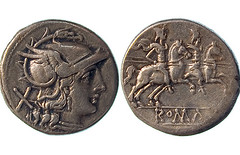 Canadian scientists probing the metal content of coins exchanged thousands of years ago in Mediterranean Europe have discovered a new way to map ancient trade patterns, to retrace economic ups and downs at the dawn of Western Civilization and even to shed new light on the collapse of the Roman Empire.
Canadian scientists probing the metal content of coins exchanged thousands of years ago in Mediterranean Europe have discovered a new way to map ancient trade patterns, to retrace economic ups and downs at the dawn of Western Civilization and even to shed new light on the collapse of the Roman Empire.
Researchers at McMaster University in Hamilton have launched a research project in which nuclear radiation is used to identify changes in metal content among ancient Greek and Roman coins held in a world-class collection amassed at the university since the 1940s.
"As we determine what the coins are made of, we are then able to reconstruct ancient trade routes, understand the development of economies and even determine the extent of counterfeiting," McMaster archeologist Spencer Pope states in a project summary issued Tuesday. "This research will help us link the archeological to the historical to understand how we, as a society, got to where we are today."
A joint project between the university's classics department and its department of medical physics and applied radiation sciences, the ancient coin initiative involves x-ray analysis and a "proton microprobe" to determine how much silver, bronze or gold is contained in each piece of money.
"We use multiple systems to look for a number of metals — gold, copper, silver — present in the outer layer of the coins," said radiation scientist Michael Farquharson. "Then we use the McMaster Nuclear Reactor to penetrate deeper into the coin to determine whether or not the coin was plated with a different material than it was actually made of."
Greater concentrations of tin, lead and other cheap metals in a coin can indicate its manufacture during a period of economic stress, inflated prices for more precious metals or low supplies of silver or bronze.
Trace elements found in each coin can help researchers pinpoint its geographic and geological origins, said Pope, allowing the team to better understand where Greek city-states turned for metal supplies and how widely coins were circulated.
So far, about 20 coins have undergone a deep probe. There are plans for another 100-coin study to expand the database of information and begin drawing more detailed conclusions about the economy of the ancient world.
To read the complete article, see:
Canadian scientists using ancient coins to map trading routes
(www.timescolonist.com/life/Canadian+scientists+
using+ancient+coins+trading+routes/3941054/story.html)
ARCHEOLOGISTS PONDER REASONS FOR FROME HOARD OF ROMAN COINS
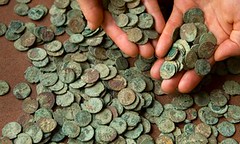 Dave Crisp found treasure on a soggy ridge outside the Somerset town of Frome last April, and helped rewrite history. On a bitter winter afternoon, as he walks the frosty field again, he recalls one of the most heart-stoppingly exciting moments of his life. The 63-year-old ex-army man had discovered a scattering of Roman silver coins in the field. He came back a few days later with his detector, bought secondhand on eBay, to round up any remaining broken pieces. The signals were faint and confusing.
Dave Crisp found treasure on a soggy ridge outside the Somerset town of Frome last April, and helped rewrite history. On a bitter winter afternoon, as he walks the frosty field again, he recalls one of the most heart-stoppingly exciting moments of his life. The 63-year-old ex-army man had discovered a scattering of Roman silver coins in the field. He came back a few days later with his detector, bought secondhand on eBay, to round up any remaining broken pieces. The signals were faint and confusing.
"I picked out a piece of Roman pottery, and when I turned it over there was a coin, a bronze radiate, stuck in it. When I turned over the next handful of clay, it was stuffed with coins — 20 at least. I just sat back on my heels and shouted: 'I've done it!'. I knew at once I'd found a Roman coin hoard in its undisturbed container — I knew the archaeologists would wet themselves."
What he found that afternoon is now stacked in a waist-high pile of shoe box-sized cardboard boxes, in a corner of an office in the coins department of the British Museum – a Diagon Alley place of mysteries, on two floors, protected by a three-inch-thick strongroom door.
The boxes hold the contents of a giant potbellied jar which lay in the clay of that sloping Somerset field for almost 2,000 years, filled to overflowing with the largest coin hoard ever found in a single container in Britain. "You can see what a job it's going to be to clean the horrors," Sam Moorhead, a Roman coins specialist, says fondly, running through his fingers a handful of disgusting bits of metal, green with corrosion, ragged with welded-on bits of other broken coins. Studying the 52,503 of them that are legible will occupy the experts for the rest of their careers.
The conventional explanation is that these hoards are either underground piggy banks, or stashed in times of danger to be recovered when normal life resumes – or never, if the feared catastrophe overwhelms the owner. This fits some finds, such as the recent discovery in Somerset of English civil war-era silver, buried when the royalists were walled up in a nearby mansion with the parliamentarians on the march. But the Frome hoard doesn't match that picture at all.
When Moorhead and Bland sorted the coins they could identify, they turned out to have been minted for 25 different emperors, but from oldest to newest, they spanned just four decades. So these were not the accumulated savings of generations of local people.
The third century AD was not a time of trauma either. The Vikings were centuries away, the Irish behaving themselves, the Roman towns and cities growing a bit ragged at the edges, but the long rolling Somerset valleys were full of prosperous Roman villas and flourishing agricultural communities.
Nor will the piggy bank explanation work. The pot could never have been carried to or from the site full – the thin pottery would have collapsed under the weight. Within a few months, as damp and dirt seeped into the jar, if the people wanted their money back, they would have had to do just what the archaeologists did: smash the container.
To read the complete article, see:
Why Frome is still cashing in on the Romans
(www.guardian.co.uk/science/2010/dec/12/
roman-coins-frome-metal-detector)
HOW PERU BECAME THE COUNTERFEIT-CASH CAPITAL OF THE WORLD
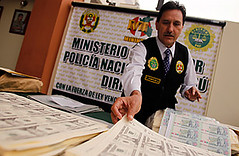 Back in the 1980s, Peru's government ran the printing presses as an answer to the country's massive economic crisis, but churning out currency only made things worse and hyperinflation topped off at 1.2 million percent by the end of the decade.
Back in the 1980s, Peru's government ran the printing presses as an answer to the country's massive economic crisis, but churning out currency only made things worse and hyperinflation topped off at 1.2 million percent by the end of the decade.
The printing presses have returned, but this time it is not the government cranking out bills, and the currency coming out is not necessarily the Peruvian nuevo sol. Some days it is euros, while others it is Venezuelan bolÍvares fuertes, or Bolivian and Chilean pesos. Most days, however, it is U.S. dollars.
In the past two years, Peru has become the No. 1 distributor of counterfeit currency internationally, according to Kenneth Jenkins, a U.S. special agent in charge of the Secret Service's Criminal Investigative Division. "Approximately $33 million has been seized in Peru since 2009, which is a substantial number," Jenkins told TIME in a telephone interview from Washington.
Officers in the Peruvian police's fraud unit estimate that a much larger sum of phony money is being printed in the country. They say that what has been seized in the past two years represents only a fraction of different bills, including Peruvian currency, being pumped out by clandestine printing presses. "Counterfeit operations have been multiplying for several years now. For every person we arrest, there are probably nine others printing bills," says one officer who, by law, cannot make his identity known.
The largest single haul so far came in early September, when police officers raided a printing press in Lima's San Juan de Lurigancho district. While the house had been under surveillance for some time, officers were stunned to discover the extent of the operation. The final tally of the six different currencies produced was just above $27 million. Fake U.S. $100 bills accounted for nearly one-third of the total, while euros accounted for another $4 million. The rest of the bills were Bolivian, Chilean, Peruvian and Venezuelan currency.
Peruvian police in the past few months have stopped people or parcels with fake U.S. bills heading to Costa Rica, Ecuador, Mexico, Venezuela and, of course, the U.S. Along they way, they have come across a vast array of methods, some quite creative, to get fake bills out of Peru. They have stopped passengers boarding flights to the U.S. with dollars stuffed into their shoes and have routinely discovered packages filled with freshly made dollars being sent through the local postal service or international couriers. One raid discovered counterfeit bills sewn into stuffed animals and destined for Ecuador, which uses the U.S. dollar as its official currency; while another found bills hidden in false bottoms of baby cribs.
To read the complete article, see: How Peru Became the Counterfeit-Cash Capital of the World (www.time.com/time/world/article/0,8599,2032152,00.html)
MORE ON THE RECOVERY OF JULIAN LEIDMAN'S STOLEN INVENTORY
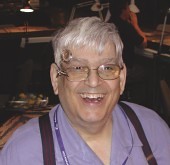 Court papers filed in New York identify the son of a Diamond District jeweler as the man who allegedly bought a multi-million dollar collection of coins and currency stolen in October 2009 from a Maryland coin dealer's van as he dined in a Montville restaurant.
Court papers filed in New York identify the son of a Diamond District jeweler as the man who allegedly bought a multi-million dollar collection of coins and currency stolen in October 2009 from a Maryland coin dealer's van as he dined in a Montville restaurant.
What the papers don't show is who the FBI believe was responsible for the theft.
A complaint filed by FBI Special Agent Daniel X. McCaffrey, Jr. details how Yan Kandinov allegedly bought the cache for $80,000 from an unidentified individual who said they had “something for him to look at.”
Kandinov then allegedly attempted to sell the coins to a New Jersey coin dealer, who in turn tipped off the FBI.
On Oct. 11, 2009, Leidman was on his way home to Silver Springs, Md., from the Coinfest show in Stamford, Conn. when he stopped at Tiffany's Restaurant along Route 46 in Montville. As he dined with family members, thieves smashed the passenger window of his locked minivan and stole two 50-pound cases containing thousands of rare coins and currency. Leidman, the American Numismatic Association's 2009 Dealer of the Year, believed that he had been tailed by the thieves after he left the coin show, who waited until he was eating to break into his vehicle.
Albert & Sons, a wholesaler of gold and diamonds, was bustling with customers on Nov. 15, the day Kandinov's trial was delayed. In his office, where a portrait of Al Capone hangs in the corner, Albert Kandinov declined to comment on the pending trial of his son.
To read the complete article, see:
Montville coin theft case involved Manhattan jeweler, FBI says
(www.nj.com/news/local/index.ssf/2010/12/
montville_coin_theft_case_invo.html)
NEW COIN: AUSTRIAN PUMMERIN BELL FIVE EUROS
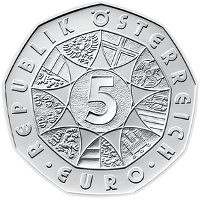
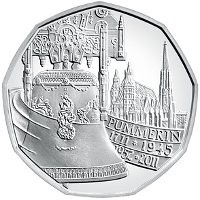
MEDAL BACK IN MALTESE HANDS AFTER AUCTION
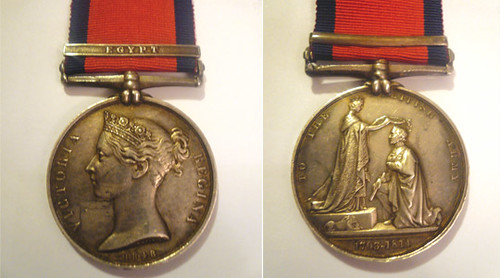
A rare medal awarded to a Maltese soldier in 1848 has made its way back into Maltese hands after it fetched £2,200 at an auction in London last week.
The medal, awarded to Lorenzo Camilleri who served with the British Expeditionary Force against Napoleon in Egypt, was bought by Tony Gauci, who is half-Maltese and an army man living in the UK.
“This medal interested me because the soldier was Maltese and also because it is so rare, with only 44 having been awarded to Maltese pioneers. More had served but only those were still alive to receive the medals about 50 years later,” Major Gauci said, adding this was also true of the British people who had served in that campaign.
Maj. Gauci has been collecting medals since he was a schoolboy and, along with those he bought over the years, has himself been awarded seven medals, having served in Iraq, Northern Ireland, Bosnia and the Falklands throughout his 30-year military career.
Only three of the rare medals were sold over the past 20 years, according to Maj. Gauci and, in the end, the medal sold for £200 over the maximum estimate of £2,000 at Sotheby's. The auction was held by Morton & Eden Ltd, an auctioneering firm specialised in numismatics.
Lorenzo Camilleri was among about 500 members of the Maltese Pioneers, an army raised in December 1800 and disbanded shortly after in 1802. He served with the British Expeditionary Force in Egypt against Napoleon at Alexandria.
To read the complete article, see:
Pioneer's medal back in Maltese hands after auction
(www.timesofmalta.com/articles/view/20101207/local
/pioneer-s-medal-back-in-maltese-hands-after-auction)
FEATURED WEB SITE: U.S LARGE CENTS OF THE YEAR 1794
This week's Featured Web Site is Jon Alan Boka's Provenance Gallery Of 1794 Large Cents.
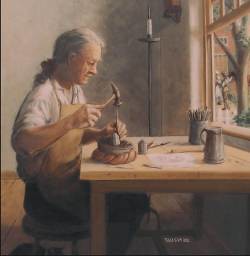
Arguably the most studied, written about and interesting of all US coins are the copper Large Cents produced between 1793 and 1857. They are also the coins with the most traceable lines of pedigree [prior stewardship]. This book evolved as an extension of an exhibit at the 2004 Early American Coppers Club convention in San Diego featuring all 58 collectible varieties of 1794 Large Cents. The coins were chosen based on their intriguing, singular pedigrees rather than condition...lineages extending to Mickley, Maris, Frossard, Hays, Zug, Prosky, Hines, Gilbert, Steigerwalt, Clapp, and many other noted collectors of the past.
www.1794largecents.com
